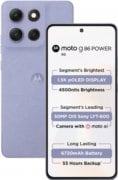- Home
- Mobiles
- Mobiles Reviews
- Huawei P30 Pro Review
Huawei P30 Pro Review

Huawei P30 Pro price in India is set at Rs. 71,990
Huawei P30 Pro is the latest flagship from the Chinese telecommunications giant. Huawei's P-series is all about photography. For the third year in a row now, the Chinese giant is aiming to outdo Apple, Samsung, and other players in the high-end smartphone space specifically in terms of camera quality and features. After experimenting with unique sensors, lenses and software features with the Huawei P10 and P20 families, we now have with us the brand new Huawei P30 Pro, the flagship of the new P30 lineup. The defining feature of this phone is its 5X optical zoom capability, which beats everything else on the market by a huge margin, and shows that Huawei's R&D and manufacturing capabilities are among the best in the world.
What's even better is that the cleverly engineered zoom lens isn't the only impressive thing about this phone's cameras or about its features overall. With an asking price in India of Rs. 71,990, the new Huawei P30 Pro has practically every feature and capability that you could think of having in a smartphone today. It will go right up against the iPhone XS Max (Review), Samsung Galaxy S10+ (Review), and Google Pixel 3 XL (Review) – not to mention Huawei's own Mate 20 Pro (Review). There's a lot to dig in to, so let's get started.
Huawei P30 Pro design
One thing that Huawei has been vocal about is that all facets of the P30 Pro — from its external appearance to the selection of notification sounds — are supposed to have been inspired by nature. In particular, Huawei has taken inspiration from salt flats, natural desert-like expanses where dry mineral deposits glisten in the sunlight. Thanks to a nine-layer “nano-optical” coating, the glass rear panel of the Huawei P30 Pro exhibits swirling, shifting colours depending on how you look at it.
There are supposed to be three colour finishes with subtle colour gradients representing different times of the day, plus a neutral black, but only two are available in India. Breathing Crystal and Aurora both have blueish gradients, but the former is much lighter with white and lilac accents, while the latter is deep and saturated with teal at the top and dark purple at the bottom. The reddish-orange Amber Sunrise and plain black options have not been launched in India, which is a pity.
Multi-colour gradient finishes are currently all the rage with Chinese brands, and we're not sure that everyone will want a phone that stands out so distinctively. Our Aurora version of the Huawei P30 Pro certainly grabbed attention, because of its colouring and also because of its sheer size and the distinctive camera modules on the rear.
The Huawei P30 Pro is big even by today's standards. It measures 158mm tall, 73.4mm wide, and 8.41mm thick. Its weight at 192g will also be a bit too much for some people's comfort. You won't have an easy time if you try using this phone with one hand, and it will feel top-heavy when typing.
The front and back of the P30 Pro are made of glass. Curiously, Huawei has not stated anywhere that it's toughened or reinforced, but the company told us the glass used is “high strength” and “tested extensively” for durability. Both glass panels are rounded at the sides, and they sandwich the phone's metal frame between them in nearly perfect sweeping curves. The top and bottom of the phone are completely flat, in contrast. The Aurora version that we're reviewing has a light blue frame that never quite matches any of the colours on the rear, and is faintly distracting when looking at the phone head-on.
On the front of the Huawei P30 Pro we have a 6.47-inch OLED panel with what might be this phone's only non-cutting-edge feature: a notch at the top. This isn't a bad thing, but other manufacturers are scoring points with all sorts of designs to liberate screen space, and since the Honor View 20 (Review) brought us a hole-punch camera months ago, it's odd that Huawei didn't try something of the sort here.
The company makes up for that by instead eliminating the earpiece. Rather than having a visible speaker, the entire upper half of the screen vibrates to produce sound. We were curious about how well this would work, and in practice it's absolutely flawless. You're guided to place your ear in the upper middle of the screen, which feels awkward, but we could hear callers just fine with the top of the phone to our ears as usual. Had we not known that this is how the Huawei P30 Pro emits sound and just used this like any other phone, we wouldn't have noticed anything different.
The P30 Pro screen also has an integrated fingerprint sensor, and although Huawei says it has been improved compared to the Mate 20 Pro, it's still slower than a standard capacitive sensor; enough to make it slightly frustrating. It also took us longer than usual to enrol our fingerprints. On the plus side, it was accurate nearly every single time we used it, and there's also face recognition as a fallback.
The OLED screen on the Huawei P30 Pro measures 6.47 inches diagonally and has a resolution of 1080x2340, but that's before accounting for the rounded corners and notch. Huawei says this display supports the wide DCI-P3 colour gamut and HDR (though there's no mention in the official spec sheet, Huawei told Gadgets 360 that the HDR10 standard is supported). If you're concerned about narrow screen borders, there's still a tiny little bit of a chin on this phone.
There's are two clusters of camera hardware on the back of the Huawei P30 Pro — one protruding module with the three selectable cameras, and another to the side with the Time-of-Flight (ToF) depth sensor, laser autofocus emitter, and dual-LED flash. When you look at the main module you can see two ordinary-looking cameras and one square window with a deeply recessed mechanism. This is the 5X optical zoom camera, and as Huawei tells us, the mechanism is actually laid out horizontally across the width of this phone, with a prism to refract light coming in. We'll have more detail on how all of these work later on in this review.
![]()
Huawei P30 Pro's quad rear camera setup
The power and volume buttons are on the right, and the sheer size of this phone means they won't always be within reach. On the top of the Huawei P30 Pro you'll find an infrared emitter that can be used to control various appliances. There's a USB Type-C port and a single speaker on the bottom – sadly, the vibrating screen isn't loud enough to be used as a speaker for media, or even as part of a stereo pair. There's no 3.5mm headphones socket.
The tiny removable tray on the bottom has slots on either side — you can have two Nano-SIMs or use one of Huawei's proprietary Nano Memory cards in the second slot to expand storage. These cards are expensive and hard to find in India, but it's unlikely you'll need one with 256GB of storage on board.
Construction quality is superb, and you get the reassurance of an IP68 certification for protection against water and dust ingress. The Huawei P30 Pro will stick out of a lot of pockets and can be awkward to use sometimes. The glass rear is not very slippery but we weren't always sure of our grip.
Huawei P30 Pro specifications and software
The Huawei P30 Pro packs the same Kirin 980 processor that we first encountered in the Huawei Mate 20 Pro and then saw in the relatively affordable Honor View 20 (Review). Both these phones have posted impressive test scores so we know that our overall usage experience should be good. The Kirin 980 is built on a 7nm manufacturing process and features two high-powered ARM 2.6GHz Cortex-A76 cores, two more Cortex-A76 cores running at 1.92GHz, and four Cortex-A55 cores for power efficiency. It also has an ARM Mali-G76 GPU, integrated LTE modem, and two “neural processing units” or AI accelerator blocks.
Huawei has launched the P30 Pro in India with 8GB of RAM and 256GB of storage. Internationally, there are also variants with 128GB and 512GB of storage, and it's strange that the company has chosen not to offer options here, especially the most affordable one. Huawei announced a new file system called EROFS (Extended Read-Only File System) last year and the P30 Pro uses it for a claimed 20 percent better read speeds and more efficient usage of storage space.
There's a 4200mAh battery, and the Huawei P30 Pro supports charging at up to 40W using the included charger and cable. Wireless fast charging is supported at up to 15W. You can also reverse-charge Qi-compatible devices such as wireless headphones, but this will be much slower.
For connectivity, the Huawei P30 Pro has Wi-Fi 802.11ac on the 2.4GHz and 5GHz bands, Bluetooth 5, dual-band GPS plus five other global satellite location services, NFC, and of course LTE with VoLTE on both SIMs. NFC can be used to make payments and unlock cars in some countries, and the latter feature might be supported by some carmakers in India in the future. The USB Type-C port works at USB 3.1 Gen1 speed (5Gbps) but only if you use your own cable – the included one works at USB 2.0 speed.
P30 Pro is the first phone that Huawei has shipped with version 9.1 of its EMUI skin and there have been some improvements over EMUI 9.0. Huawei says the new default icon grid is more spaced out with larger icons, and all visual elements have been redesigned.
![]()
Huawei P30 Pro has a waterdrop-shaped display notch
One interesting feature is Huawei's GPU Turbo 3.0, which is claimed to optimise performance in 25 popular games including PUBG Mobile, Fortnite, Real Racing 3, Minecraft, and PES 2019. It uses machine learning to identify how the Kirin 980 processor can be optimised for responsiveness and power consumption with each game.
Huawei P30 Pro has a basic always-on display option which is disabled by default. Within the Settings app, you'll find the Android 9 Digital Wellbeing tool (renamed to Digital Balance), toggles for a few gestures and shortcuts, and the ability to clone some messaging apps. There's a themes app but customisation isn't as deep as some other custom UIs allow — we would have liked the ability to enable an app drawer rather than having all icons on the home screens.
Our unit had some preloaded apps including Facebook, Messenger, Netflix, Booking.com, and Camera360. There's a ‘Top Apps' folder that displays ads for “recommended apps”. Huawei's own apps include the HiCare service app, Tips, Notepad, SOS alerts, Ride Mode to discourage distracted driving, and the AppGallery app store.
Huawei P30 Pro performance and battery life
As expected for a phone that costs so much, there are no issues at all with performance in day-to-day usage. Multitasking on the Huawei P30 Pro is a breeze and apps seem to load quickly. Knuckle gestures are recognised immediately. In terms of usability, the slight delay when using the in-display fingerprint sensor is the only downside here.
When we first started using this phone, we got annoyed by the sheer number of “helpful” tips that Huawei thinks it's necessary to display. These included notifications as well as full-screen popups that interrupted what we were doing. Hopefully, this will only be a problem for a little while.
The screen on the Huawei P30 Pro is crisp, though a QHD+ resolution would have been preferable for one this size. We did have a little trouble with reflections outdoors in the daytime, especially at the edges thanks to the curved glass. Colours are vibrant and pop nicely. The single speaker is loud and clear, but music lacks punch and there's hardly any bass at all.
The Huawei P30 Pro lets you choose between the default Vivid colour profile and a Standard mode which looked too pale and lifeless to us in comparison. You can also tweak the white balance using a colour wheel, which is a more granular level of control than anyone should really need.
Most videos played with a black band masking the front camera notch, which is fine. Games and video clips looked great, with smooth motion and excellent contrast. HDR was evident in YouTube videos. Once again, we found the curved screen edges distracting.
We ran our standard benchmarks to check the Huawei P30 Pro's performance objectively. AnTuTu gave us a strong score of 282,444, and Geekbench's single-core and multi-core test results were 3,274 and 9,730 respectively. As for graphics, we got 3,582 points in 3DMark's Sling Shot Extreme test, as well as 49fps and 28fps respectively in GFXBench's Manhattan 3.1 and Car Chase scenes.
![]()
Huawei P30 Pro is offered in two colour variants, with Aurora seen above
PUBG Mobile and Asphalt 9: Legends are relatively demanding game titles when it comes to graphics, and both of them were perfectly smooth running at the highest quality. We had a very enjoyable time playing both games.
The 4200mAh battery inside the Huawei P30 Pro easily lasted us a day and a half with ordinary usage. We did notice that using the cameras seemed to make the battery level dip more than anything else. Our HD video loop test ran for 18 hours, 14 minutes in total. Video playback was suspended automatically when the battery level dropped to five percent, and we resumed it till the phone died.
With the phone completely dead, we plugged in the 40W SuperCharger and we were amazed to see that in just one minute, the charge level went up to 4 percent, and in ten minutes, it was up to 26 percent. In 30 minutes, we were up to 65 percent. A full charge of the Huawei P30 Pro took just a shade over one hour. We should note that the phone did get uncomfortably warm while charging rapidly.
Huawei P30 Pro cameras
Huawei has gone all-out with the cameras on this smartphone, and has already managed to win DxOMark's highest ever score for still photography. The 40-megapixel primary camera has a unique “SuperSpectrum” sensor with an R-Y-Y-B filter for each pixel. The company says this allows 40 percent more light to hit the sensor than standard R-G-G-B filters. The ISO level goes up to 409,600, and the sensor itself measures 1/1.7 inches with an f/1.6 aperture and optical stabilisation. All of this means that low-light shots should be stunning.
The second camera on the Huawei P30 Pro is an ultra-wide-angle 20-megapixel f/2.2 unit which you can use to capture panoramas and large group shots, or objects you're standing very close to. While nice to have, it doesn't offer anything out of the ordinary.
The real star of the show is an incredibly clever bit of engineering — Huawei's periscopic optical zoom camera. This brings a whole new level of photographic capability to smartphones, and it's currently unmatched by anyone else, including heavy hitters Apple, Samsung, and Google. Not only do you get 5X optical zoom, but also 10X “hybrid” and up to 50X digital zoom, though this last capability is arguably not of much value.
The telephoto camera on the Huawei P30 Pro also has optical stabilisation which is handy since every slight hand movement is amplified more and more as you zoom in. The tradeoffs are that the resolution is only 8 megapixels, and the aperture is a disappointing f/3.4 making this camera useless at night. In fact, the camera app will use digital zoom through the primary camera and simply not switch to this one if it detects even a slight drop in ambient light, and that includes indoors in the daytime. There's no indication to the user of when this is happening, but we learnt to spot the difference.
![]()
![]()
![]()
![]()
![]() Top to bottom: 0.6X ultra-wide; 1X standard; 5X optical zoom; 10X hybrid zoom; and 50X digital zoom with the Huawei P30 Pro
Top to bottom: 0.6X ultra-wide; 1X standard; 5X optical zoom; 10X hybrid zoom; and 50X digital zoom with the Huawei P30 Pro
The final rear camera is a Time-of-Flight (ToF) depth sensor that is used to create a 3D map of a scene in order to separate backgrounds and foregrounds to a high degree of accuracy. It works quickly and has uses in AR, 3D object scanning and gaming that Huawei says it will explore with future software updates. An AR app that will let users map and measure objects and spaces has been promised to Huawei P30 Pro buyers for early May.
The single front camera on the Huawei P30 Pro is a relatively simple affair with a 32-megapixel sensor and f/2.0 aperture. There are some beautification options and effects that you can apply, but you can't preview before taking a shot.
Huawei also touts its AI features, enabled by the Kirin 980 SoC. AI is enabled by default and can recognise objects in a scene, and also take multiple exposures for HDR processing. HiVision is a feature that attempts to identify objects, landmarks, text, and more. You can get automatic translations, search online shopping sites, and even estimate the calorie counts of meals.
The Huawei P30 Pro camera app layout is fairly standard, with a carousel on the bottom to switch modes and quick toggles on the top. It can be awkward to try to reach some of them when holding the phone up to frame a shot. Many more modes are available in a spillover menu. You can choose from different bokeh styles in the Portrait mode, which works only on human faces. There's a separate Aperture mode for depth-of-field effects. A Pro mode offers plenty of controls and overrides all AI tweaks.
We've discussed the quality of the photos the Huawei P30 Pro takes in great detail when we pitted this phone against the Samsung Galaxy S10+ — winner of our earlier camera shootouts — in a flagship camera showdown, which you can read right here. Huawei's new offering is certainly disruptive when it comes to zoom capabilities and low-light photography, and it is definitely one of the best phones you can buy right now if cameras are your top priority. That said, it did not win the comparison hands down.
We were truly impressed with the crispness and level of detail that we managed to capture with the Huawei P30 Pro, be it in wide shots, close-ups, or zoomed-in shots. Some of the macros we took were truly amazing. The portrait mode effects didn't always work and there were some awkward spots where edge detection went wrong. For everyday shots, we would have liked the colours to have been a bit more vivid too.
![]()
![]()
![]() Tap to see full-sized Huawei P30 Pro camera samples. Top to bottom: macro; low-light in automatic mode; selfie with lighting effect. Click here to see more Huawei P30 Pro camera samples.
Tap to see full-sized Huawei P30 Pro camera samples. Top to bottom: macro; low-light in automatic mode; selfie with lighting effect. Click here to see more Huawei P30 Pro camera samples.
We had a lot of fun playing with the telephoto camera on the Huawei P30 Pro, though the inability to use it at night was disappointing. We took several sets of shots at 0.6X (ultra-wide), 1X, 5X, 10X and 50X while standing in the same spot, and to our surprise, the 10X hybrid zoom samples turned out looking quite good. Even at 50X, while the results were definitely blotchy, we could grab some useful details such as text printed on a very distant object.
At first, we were a little confused by the Night mode on the Huawei P30 Pro because results were hardly better than what we could capture in Auto mode, and we were instructed to hold perfectly still for up to 8 seconds while shots were being captured. We soon realised that the combination of the new sensor and low aperture meant that the P30 Pro's night shots taken in Auto mode are just as good as those that other phones produce using long exposures and raising the ISO level.
Night shots taken with the Huawei P30 Pro came out with discernible details and colours where most ordinary phones would have produced grey noise. Where Night mode did come in handy was in scenes with tricky exposures — points of light that would become streaks or blobs with long exposures were rendered much more crisply.
The 32-megapixel front camera did a decent job, but depth effects were not great, which wasn't a surprise. We turned beautification down completely and were pleased with the quality overall. When recording video, you can switch between lenses on the fly, but digital zoom is limited to 15X. The optical stabilisation works brilliantly, and footage taken while we were walking was nicely ironed out.
Verdict
Huawei has delivered a set of cameras that far surpass Apple, Samsung, and Google's current flagships in terms of features and capabilities. The 5X optical zoom is a game-changer, and low-light shots are a class apart. However, as our detailed camera comparison has already shown, there are some cases when the P30 Pro does not deliver the best shot, and some cases when you might subjectively prefer another option.
Other than its cameras, the Huawei P30 Pro is strong, but so are its competitors. You'll get a great-looking phone with good battery life and top-notch build quality no matter which way you decide to go. The P30 Pro's display isn't as crisp as other phones at this price level, and the processor will likely not compare favourably against the Snapdragon 855 powered offerings that will soon flood the market. If you like your phones understated, the bright colours of the P30 Pro won't appeal to you.
Priced at Rs. 71,990, the Huawei P30 Pro isn't perfect, but you'll be very happy choosing this phone over the iPhone XS Max (Review), Samsung Galaxy S10+ (Review), and Google Pixel 3 XL (Review) if photography is your preferred creative outlet.
For the latest tech news and reviews, follow Gadgets 360 on X, Facebook, WhatsApp, Threads and Google News. For the latest videos on gadgets and tech, subscribe to our YouTube channel. If you want to know everything about top influencers, follow our in-house Who'sThat360 on Instagram and YouTube.
Related Stories
- Samsung Galaxy Unpacked 2025
- ChatGPT
- Redmi Note 14 Pro+
- iPhone 16
- Apple Vision Pro
- Oneplus 12
- OnePlus Nord CE 3 Lite 5G
- iPhone 13
- Xiaomi 14 Pro
- Oppo Find N3
- Tecno Spark Go (2023)
- Realme V30
- Best Phones Under 25000
- Samsung Galaxy S24 Series
- Cryptocurrency
- iQoo 12
- Samsung Galaxy S24 Ultra
- Giottus
- Samsung Galaxy Z Flip 5
- Apple 'Scary Fast'
- Housefull 5
- GoPro Hero 12 Black Review
- Invincible Season 2
- JioGlass
- HD Ready TV
- Laptop Under 50000
- Smartwatch Under 10000
- Latest Mobile Phones
- Compare Phones
- iQOO Z10 Turbo+
- Vivo T4R 5G
- Ulefone Armor 33 Pro
- Ulefone Armor 33
- Redmi Note 14 SE 5G
- Lava Blaze Dragon 5G
- Infinix Smart 10
- Realme 15 Pro 5G
- Samsung Galaxy Book 4 Edge
- Acer Nitro Lite 16
- Honor Pad X7
- Honor Pad GT 2 Pro
- CMF Watch 3 Pro
- boAt Valour Watch 1 GPS
- TCL C72K QD Mini‑LED TV
- Haier 43 Inch QLED Ultra HD (4K) Smart TV (43H6E)
- Asus ROG Ally
- Nintendo Switch Lite
- Haier 1.6 Ton 5 Star Inverter Split AC (HSU19G-MZAID5BN-INV)
- Haier 1.6 Ton 5 Star Inverter Split AC (HSU19G-MZAIM5BN-INV)



















